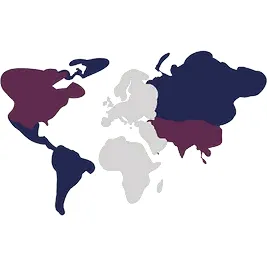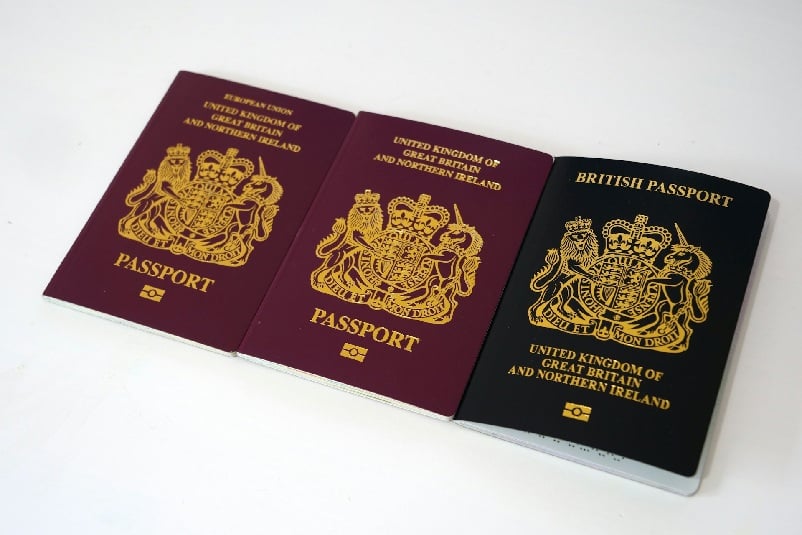How to immigrate to Canada from USA in 4 easy steps (and why are people moving now)
Applications to move to Canada from the US have multiplied recently, with people citing economic, political, and lifestyle reasons. There is a clear pathway between the two countries with positive relations and favorable immigration routes.
Call us on +1 844 290 6312 to find out how you can make your move to Canada a reality. We’re here to help in person, on the telephone or via live chat.
Read our 1001 reviews
Applications to move to Canada from the US have multiplied recently, with people citing economic, political, and lifestyle reasons. There is a clear pathway between the two countries with positive relations and favorable immigration routes.
This guide explores:
- Motivations for moving to Canada from the USA
- The cost of moving to Canada
- Moving to Canada in 4 easy steps
- Part-time residence vs full-time residence
- Visa pathways
- Applications
Why people are considering leaving the US for Canada?
Choosing to leave the USA for Canada can be for many reasons. A shift in the political system has led to a large increase in people looking to leave the US. We look at the most common reasons people give for their Canadian relocation:
Safety and security
Many choose Canada for its lower crime rates and low gun violence, which compare favourably to the USA. Canada has around 3 times fewer cases of gun violence. The Global Peace Index consistently ranks Canada as one of the top 10 safest countries in the world.
Multiculturism & immigration acceptance
It is considered safer for minorities and the LGBT community in Canada than in the US. There is a high tolerance for Immigration as a stimulant for economic growth and prosperity.
Political beliefs
Some people depart the US because their political or societal beliefs conflict with those of the White House. For some, leaving the US could be forced if incoming president Donald Trump’s plans for mass deportation are realised during his term in office. For others, a political system may not fit their ideals. In contrast to the USA, Canada is more pro-immigration and left-of-centre than the US.
Public Services
Canadians can access free healthcare, paid for through their taxes. The healthcare system is considered high-quality, ranking among the best in the world, and generally covers doctor appointments, emergency care, and hospital visits free of charge. There can be a waiting period for free healthcare coverage. In some provinces you may need to wait, and purchase a private medical insurance plan.
Education is also free for those aged 5 or 6 to 18, depending on the province. In some provinces, international student fees may apply, but permanent residents should be able to access education without issue, especially if they can show a long duration.
Higher wages, job opportunities & work-life balance
Factoring in the exchange rate, Canadian jobs typically pay more than US jobs. With many labour shortages, particularly after the COVID-19 pandemic, many roles are available in Canada, especially in in-demand professions like engineering, healthcare, digital and web development and finance.
Work-life balance is considered more of a focus in Canada, and most Canadians have more legal rights to holiday pay, while in the US, it can sometimes be at the employer’s discretion.
Lower cost of living
While not all Canadian cities will be cheaper than US towns, for example, they typically fare well compared to US cities. Global Admissions calculates the overall cost of living as being up to 13% cheaper in Canada than in the US. Generally, the cost of living is cheaper in Canada across the board.
How Easy Is It to Move to Canada?
For US citizens, moving to Canada is relatively straightforward, especially for skilled workers or family sponsorships. However, processing times can range from 6 months to 2 years, depending on the immigration route. Canada offers a range of settlement programs, like Language Instruction for Newcomers and community services, but the adjustment to Canadian life—especially in terms of job markets and cost of living—may still pose challenges.
Considerations for Moving to Canada
When moving to Canada from the US there are practical factors you’ll need to consider, including housing, taxes, healthcare, and required registrations.
Housing in Canada
The Average studio in the US costs around $1,800 per month, versus $1600 in Canada. Major cities are higher in both countries, but Canada is typically lower. Living in Toronto, for example, is up to four times cheaper to rent than living in New York City. Websites like Realtor.ca or Kijiji can help you explore housing options. You’ll also need a Canadian credit history if renting long-term, but new arrivals can often secure housing with a security deposit.
Taxes in Canada
Canada’s tax system is similar to the US in that it’s progressive, with federal tax rates ranging from 15% to 33%, depending on your income. Provinces also impose their own taxes (e.g., Ontario’s provincial tax ranges from 5% to 13.16%). You’ll also pay a GST/HST tax on goods and services (typically 5-15%). As a Canadian resident, you’ll need to file your taxes annually with Canada Revenue Agency (CRA). Like the US, Canada offers tax credits and benefits, such as the Canada Child Benefit.
Healthcare and Insurance
Canada’s healthcare system is publicly funded, meaning basic medical services are free of charge, though prescriptions, dental, and eye care may not be covered. To access healthcare, you must register with your province’s health insurance program, which can take up to 3 months. In the meantime, many newcomers choose private insurance.
Other Registrations and Systems
Upon arrival, you’ll need to register for several essential services:
- Social Insurance Number (SIN): Required to work and pay taxes.
- Health Card: For healthcare access, after registering with your provincial health system.
- Driver’s License: If you’re transferring from the U.S., some provinces allow direct exchanges; otherwise, you’ll need to take driving tests.
- Bank Account: You’ll need identification (passport or work permit) to open a Canadian bank account.
How to Move to Canada from the US – in 4 easy steps
We break down how to move to Canada in 4 easy steps.
- Decide if you are looking for part time or permanent residency
- Choose your visa route
- Assess your eligibility
- Apply
Step 1. Part time resident vs Full time resident
The first step to establishing your pathway to Canada is deciding which route you are looking to take. Those who want to live in the US and Canada and have flexible working commitments might apply as a part-time resident, while those looking to relocate permanently will choose full time residency
Permanent Residency
Full-time residence in Canada comes with unique benefits. You can typically work or study in Canada without restriction and may be eligible to access healthcare through your province.
Part-time Residency
Becoming a part-time resident in Canada enables US citizens to retain US residency while spending up to six months a year in Canada. Typically popular with retirees and remote workers, part-time residency can offer a more flexible lifestyle well-suited to digital nomads.
Step 2. Choosing your US to Canada visa route
There are multiple options for moving to Canada from the US, all of which have bespoke entry requirements and application processes.
Main Canadian Visa Options
Canadian Visa Types
Provincial Nominee Program (PNP)
You must be nominated by a province to be eligible for PNP.
Canadian Experience Class (CEC)
For those with Canadian work experience looking for PR fast-track.
Quebec Skilled Workers Program (QSWP)
Skilled workers in Quebec can access the Quebec Skilled Workers Program (QSWP)
We can help you study in Canada, providing support for your studies and beyond.
Atlantic Immigration Program (AIP)
Allowing immigration for graduates or workers in New Brunswick, Prince Edward Island, Nova Scotia, or Newfoundland and Labrador
For workers in occupations in the Agri-Food industry
Immigrate by providing care for children, elderly individuals, or those with medical needs, or by working as a live-in caregiver.
Federal Skilled Worker Program (FSWP)
For skilled workers with foreign work experience seeking to become permanent residents of Canada.
Allows Canadian citizens or permanent residents to sponsor their family members for permanent residence.
Federal Skilled Trades Program (FST)
For skilled tradespeople who want to become permanent residents based on their work experience in a trade.
Step 3 – Assessing Eligibility
Your eligibility for each program depends on multiple factors including:
- Employment immigration routes are dependent on your skills, experience, education, age and language skills for example. For the Express Entry system, you must have the required CRS score.
- Family sponsorship routes depend on the sponsor being a Canadian citizen, permanent resident, or registered in Canada as an Indian under the Canadian Indian Act.
- Asylum and Humanitarian Protection routes depend on exceptional circumstances that may mean you need protection from your home country, because of the political, or social situation, if returning home might present a risk to your life.
- Various programs and pilots are employed to attract skilled people to smaller towns and provinces, aimed at filling labor shortages. Typically a job offer is required.
Express Entry

Many employment immigration applications in Canada are processed through the Express Entry System. Express Entry is the fastest system, with applications processed online for most permanent residency applications within 6 months.
Express Entry Eligibility
Express Entry is solely for Permanent Resident applications and focuses on employment and business immigration routes. You can use the express entry system when applying for the following visas:
- Federal Skilled Worker Program (FSWP)
- Federal Skilled Trades Program (FSTP)
- Canadian Experience Class (CEC)
- Provincial Nominee Program (PNP) – Express Entry Stream
Express Entry is score-based using a CRS Score. Each candidate is ranked against other applicants. The highest-ranking candidates are invited to apply under Express Entry based on round types. Each round type has a cut-off score which varies depending on the quality and quantity of applicants). The rounds include:
- General (Usually a cut-off of around 500 points)
- Program-Specific can be as low as 70 points for the Canadian Experience Class (CEC) and as high as 600 for the Provincial Nominee Program (PNP).
- Category-Based selection is based on more specialist job roles. The CRS score required is generally lower, and is usually between 336 to 437
How do you get CRS points?
Points are awarded based on a number of factors including:
- Age is a factor with those between 20-29 receiving the most points (110), while those 30-35 receive 95. No points for 45+.
- Education is another factor. A PhD earns the maximum (150), Bachelor’s degree earns up to 112 points, while high school education earns fewer points (30).
- Language skills are an important factor. High scores on tests like IELTS or CELPIP can contribute up to 136 points per language for the primary candidate
- Provincial nomination (this automatically incurs 600 points, almost guaranteeing your entry into the final pool)
- Work experience is split into foreign and Canadian work experience, with Canadian work experience bringing up to 80 points for over 5 years skilled work experience in Canada. Foreign work offers up to 50 points for three years of experience.
- Spouse score is accounted for. The education, language, and work experience of a spouse can contribute up to 40 points.
The score required depends on the round, and competition for each immigration route. Here is the range of candidate scores from the October 2024 pool:
Candidate CRS scores
| CRS Score Range | Number of Candidates |
|---|---|
| 601-1200 | 124 |
| 501-600 | 13,430 |
| 491-500 | 11,925 |
| 481-490 | 12,240 |
| 471-480 | 14,914 |
| 461-470 | 12,900 |
| 451-460 | 11,306 |
| 401-450 | 55,503 |
| 441-450 | 10,931 |
| 431-440 | 12,047 |
| 421-430 | 10,583 |
| 411-420 | 11,071 |
| 401-410 | 10,871 |
| 351-400 | 51,048 |
| 301-350 | 22,928 |
| 0-300 | 5,462 |
| Total | 211,780 |
Visa Programs Outside Express Entry:
Each program has distinct entry requirements, and unlike Express Entry, you are not in direct competition with other applicants. If you meet the criteria for entry, making a strong case for your Canadian immigration, there are routes available.
Non-Express Entry Eligibility Family Sponsorship: Available if a Canadian citizen, permanent resident, or someone registered under the Indian Act sponsors you. Sponsors must meet the Minimum Necessary Income (MNI) to support family dependents, ensuring they can provide financial support.
Provincial Nominee Program (PNP): Non-Express Entry streams allow candidates to be nominated directly by a province, based on provincial labor needs and specific criteria. Each province has its own eligibility requirements, often including a job offer or specific work experience in high-demand sectors.
Quebec Skilled Worker Program (QSWP): Quebec has a distinct system separate from Express Entry, designed for individuals with French language proficiency who wish to live and work in Quebec. Candidates are selected based on points awarded for age, language, education, and work experience.
Atlantic Immigration Program (AIP): This program is tailored to fill labor shortages in Canada’s Atlantic provinces (New Brunswick, Newfoundland and Labrador, Nova Scotia, and Prince Edward Island). Eligibility often requires a job offer from an employer in one of these provinces.
Startup Visa Program: This program is for entrepreneurs who want to start a business in Canada. Eligibility includes securing support from a designated Canadian venture capital fund, angel investor, or business incubator.
Rural and Northern Immigration Pilot (RNIP): Community-driven immigration pilot for candidates who have a job offer in a designated rural or northern community, aimed at encouraging population growth in smaller towns and regions.
Agri-Food Pilot: This program is for workers with experience in agriculture or agri-food industries. Eligible candidates with job offers in these sectors can transition to permanent residency.
Caregiver Programs: Available for individuals with experience providing care for children or adults with high medical needs. Home Child Care Provider Pilot and Home Support Worker Pilot both require specific work experience in Canada.
Humanitarian and Compassionate Grounds (H&C): For applicants who do not meet other immigration criteria but have unique circumstances, such as medical or family hardships, that justify their stay in Canada.
Refugee and Asylum Program: Offers protection to individuals facing persecution or risk in their home country. Applicants can be government-assisted or privately sponsored by organizations or groups in Canada.
Canada Visa Processing Times (Non-Express Entry Streams)
| Program | Processing Time |
| Family Sponsorship | 12-24 months |
| Provincial Nominee Program (PNP) | 15-19 months |
| Quebec Skilled Worker Program (QSWP) | 15-17 months |
| Atlantic Immigration Program (AIP) | 6-12 months |
| Startup Visa Program | 12-16 months |
| Rural and Northern Immigration Pilot (RNIP) | 12-18 months |
| Agri-Food Pilot | 12-24 months |
| Caregiver Programs | 12 months (pilot-specific) |
| Humanitarian and Compassionate Grounds (H&C) | 22-36 months |
| Refugee and Asylum Program | Varies greatly (months to years, depending on case and circumstances) |
Step 4 – Applying for your Canadian Visa
Express Entry Process
- Create an Express Entry profile online
- Ranked by CRS score; highest-ranking candidates are invited based on round type.
- Submit an application for permanent residency (PR) within 60 days of receiving an ITA.
Non-Express Entry Streams
- Apply directly through provincial, family sponsorship, or specialized programs outside of Express Entry.
- Processing times vary depending on the program, typically ranging from 12 months to 2 years.
How IAS Can Help
Our experienced Canadian lawyers can help make your immigration to Canada from the US stress-free. We can help you explore routes, pathways and possibilities for you and your family to begin a new life in Canada.
We help you navigate changes, challenges, and ensure a smooth pathway to Canada from the US. Our highly-skilled team have helped thousands of immigrants get the permissions they need, and they can help you too.
Call the IAS team on +1 844 290 6312 or use our live chat service to find out more out our services.
Table of Contents
Table of Contents will appear here.Legal Disclaimer
The information provided is for general informational purposes only and does not constitute legal advice. While we make every effort to ensure accuracy, the law may change, and the information may not reflect the most current legal developments. No warranty is given regarding the accuracy or completeness of the information, and we do not accept liability in such cases. We recommend consulting with a qualified lawyer at Immigration Advice Service before making any decisions based on the content provided.















